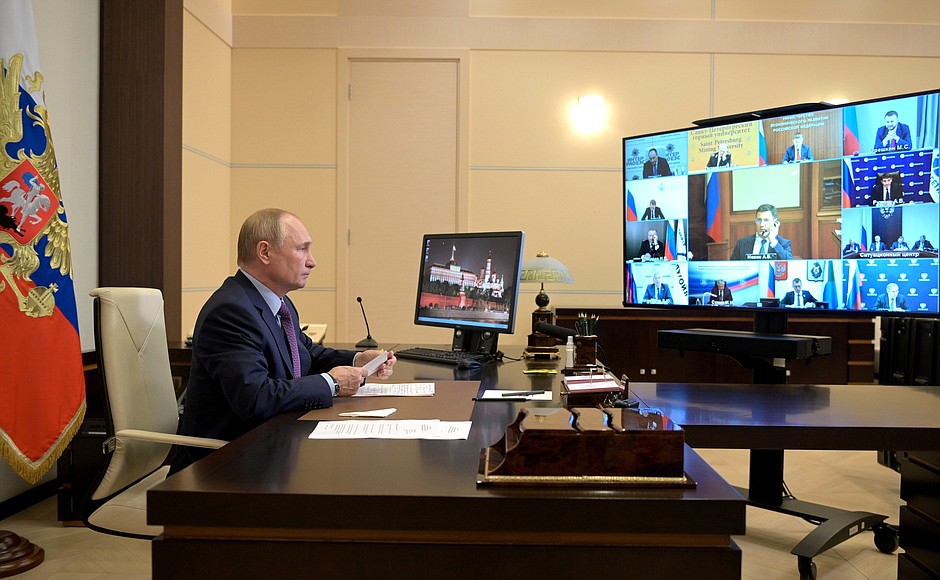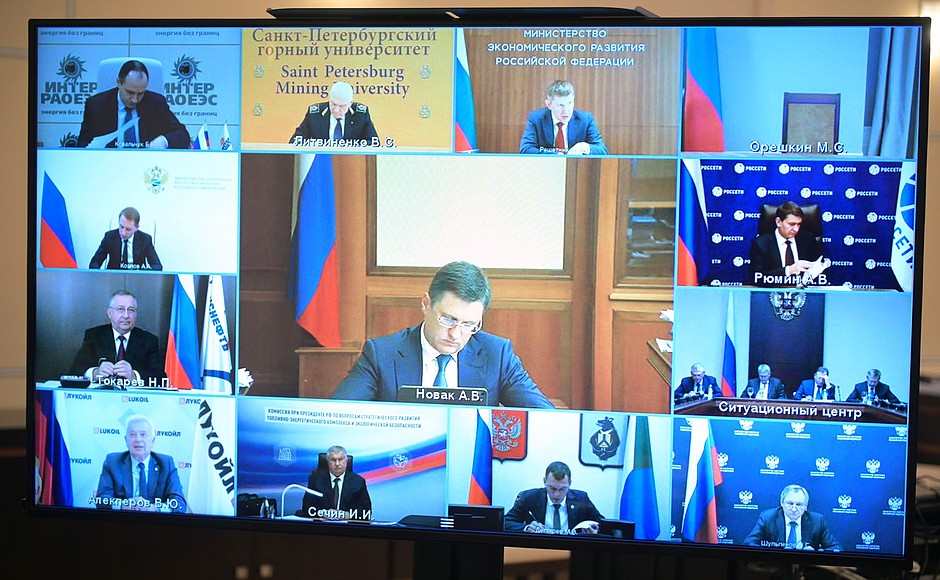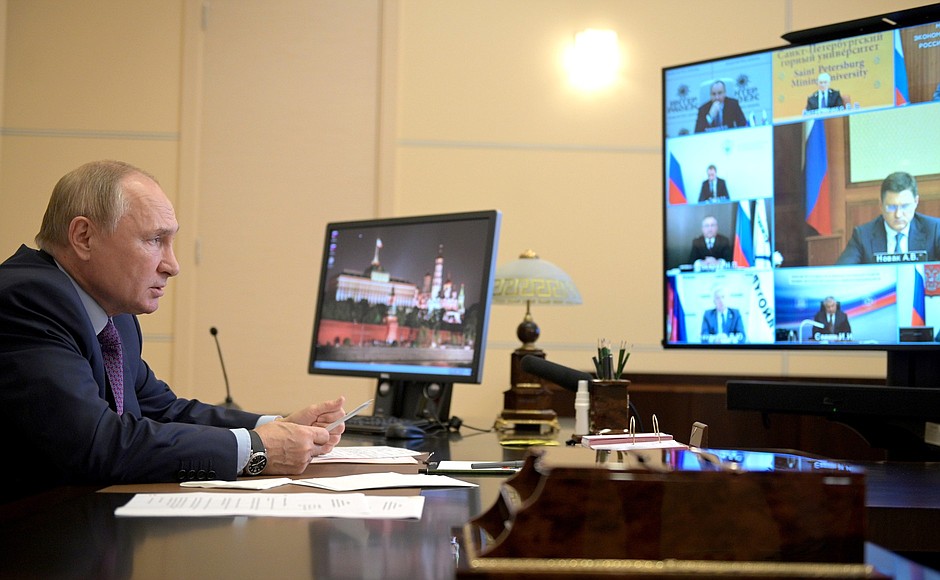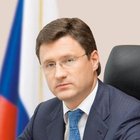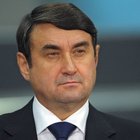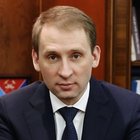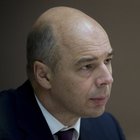The meeting was attended by Deputy Prime Minister Alexander Novak, presidential aides Igor Levitin and Maxim Oreshkin, Minister of Natural Resources and Environment Alexander Kozlov, Minister of Industry and Trade Denis Manturov, Minister of Economic Development Maxim Reshetnikov, Finance Minister Anton Siluanov, Energy Minister Nikolai Shulginov, Head of the Federal Anti-Monopoly Service Maxim Shaskolsky, governors and heads of major energy companies.
* * *
President of Russia Vladimir Putin: Good afternoon, colleagues.
Yesterday we reviewed long-term plans linked with global climate policy and today I suggest discussing in more detail the current situation in the energy market and prospects for its development.
A number of governors of Russian regions are taking part in our meeting. I believe this is a good opportunity to jointly analyse the regional aspects of major processes occurring in the global energy market.
Now, the world economy is recovering well after the past year’s crisis. The demand for energy is growing and, hence, prices are soaring.
As you know, the global energy market does not tolerate hectic moves and vagaries. Investment plans in this area are long-term. Therefore, any abrupt and rash actions may lead, and, judging by the current market situation, are already leading to serious imbalances like those we are seeing in the European market that has been affected this year by several unfavourable factors all at once.
First, the rapid post-crisis recovery of the economy has “heated up” the energy demand.
Second, gas reserves in many European countries’ underground storage facilities dwindled as a result of the harsh winter in early 2021. I am referring precisely to their underground gas storage facilities, the underground storage facilities of our European partners.
Third, the production of wind energy declined noticeably later in the summer because of hot and windless weather. It should also be taken into consideration that the energy balance has changed dramatically in Europe over the past ten years. Many countries in the region have given up their coal-burning and nuclear power plants in favour of wind power generation that is heavily dependent on weather conditions.
And, finally, fourth, the practices of our European partners [are to blame]. These practices have reaffirmed that, properly speaking, they have made mistakes. We were talking with the former European Commission; all of its activities were aimed at curtailing the so-called long-term contracts and at transitioning to gas exchange trading.
It turned out – and today this is absolutely obvious – that this policy is erroneous, erroneous for the reason that it fails to take into account the gas market specifics dependent on a large number of uncertainty factors. Consumers, including, for example, fertiliser producers, are losing all price benchmarks. All of this is leading to failures and, as I said, imbalances.
As a result, the gas price has broken all historical records. Today it is approaching $2,000 per thousand cubic metres of gas, which is over ten times last year’s average price. I would like to ask my colleagues to report in detail on the developments.
In the meantime, I would like to underscore that Russia has always been a reliable supplier of [natural] gas to its consumers all over the world, both in Asia and Europe. Russia always fulfils all its obligations in full – all its obligations, I would like to stress this.
Right before this meeting, I looked at a reference paper from Gazprom. Our exports outside of the former Soviet republics, primarily to Europe, of course, were at a record high in 2018, dwarfing deliveries to Asia that did not have any serious impact on these figures.
So, in 2018, we hit a record high of 201.7 billion cubic metres. In 2019, our partners asked for less, so deliveries were slightly lower at 199.4 billion cubic metres. Marked by the pandemic, 2020 saw a decline in European manufacturing, dragging gas exports down to 179.35 billion cubic metres. The economy has been recovering in 2021. In the first nine months, deliveries increased 18.8 billion cubic metres or by 15 percent year-on-year. If this momentum carries on, our fuel exports to Europe, including natural gas, can very well set a new record.
By the way, Gazprom’s long-term gas export contracts set forth minimum and maximum supply levels, and Gazprom has never refused requests for more supplies from its consumers, as long as they filed the relevant applications. There was not a single instance when Gazprom turned down an application.
The Federal Republic of Germany is Russia’s biggest European consumer. In the first nine months of 2021, it increased its natural gas imports from Russian by 10.12 billion cubic metres to 131.8 percent compared to the same period last year. Even in 2020, when the overall deliveries to Europe declined year-on-year, we still increased exports to Germany by 4.7 billion cubic metres, which gives us 112.9 percent.
I have to say that there has been all kinds of speculation on Ukraine’s gas transit system and deliveries through this country. I would like to reiterate that under the contract we have to pump 40 billion cubic metres of gas through Ukraine’s gas transit system per year. In the first nine months of 2021, Gazprom increased its supplies, or should I say transit volumes through Ukraine, by more than eight percent. We have every right to believe that we will exceed our contractual obligations in terms of gas transit through Ukraine.
Further increasing these volumes does not make economic sense for Gazprom, since costs will also be higher. It is much cheaper to supply gas using the new pipelines, saving us about $3 billion per year for the supply volumes in question.
In addition, I would like to inform those who actually care about preserving the environment, instead of just using this as a political weapon, that the new pipelines that were launched over the past years or are about to become operational can reduce CO2 emissions 5.6 times thanks to their new equipment. Accordingly, supply volumes go up, while emissions go down. This has to do with the superior characteristics of these pipelines enabling them to pump gas at a higher pressure.
Everyone must know this.
Nevertheless, colleagues, today I would like you to present your proposals about what else can be done to stabilise the global energy market. We are ready for this work and would like this to be a fully commercially based project, with due regard for the interests of all the participants in this process.
I would like to emphasise that the current situation on the European energy market is another clear example of the fact that hasty, let alone politically influenced decisions are unacceptable in any sphere, but especially so when it comes to energy supply on which the sustainable operation of enterprises and the welfare and quality of life of millions depends.
Therefore, our decisions regarding the development of the fuel and energy complex of our country, Russia, must be prudent, taking into account our national interests and, most importantly, the needs of our citizens, and, of course, they must be sustainable in the long run. We must try to take a look beyond the horizon of not just one decade, but two or three decades.
According to international experts, including OPEC, the demand for oil will begin to decelerate from 2035, but overall oil consumption will be increasing until 2045, approximately by 0.7 percent annually.
The demand for natural gas will continue to grow faster, by over 1 percent annually, primarily because gas as a cleaner fuel will be replacing coal in the global energy balance.
International experts believe that the demand for coal will increase slightly over the next five years, especially in Southeast Asia, then, according to their forecasts, it will reach a plateau in 10–15 years before decreasing.
But we must make a comprehensive analysis of the impact of potential changes in the energy sector, their influence on our economy, and thoroughly consider all possible development scenarios.
Our actions, such as transition to the budget guidelines and the continuing replenishment of the National Wealth Fund, ensure the long-term stability of our economy regardless of any developments in foreign policy or foreign economic activity, as the past year has amply demonstrated.
At the same time, we must diversify our economy, actively investing in infrastructure and the creation of new enterprises. Special attention should be given to our coal-producing regions, where new jobs must be created outside the coal sector. I have already issued these instructions.
Today I would like to hear a comprehensive report on what has already been done in this regard, and I also propose that today we discuss the development of new promising energy spheres, including small nuclear power stations, hydrogen energy and renewable energy sources, such as tidal energy, which could have enormous potential.
We talked about this only yesterday. Yes, there are many unresolved matters in that sphere, but we must definitely think about this, launch the necessary studies, including scientific research, and do this very seriously and thoroughly, thinking, as I have already mentioned, several decades ahead.
Let us get down to our agenda. Deputy Prime Minister Alexander Novak has the floor.
<…>
Deputy Prime Minister Alexander Novak: Speaking about the gas market, it has also rebounded to the pre-crisis level. You have spoken in detail about the crisis that is unfolding in Europe and Asia. Prices have soared there by $500 in one day. It is obvious that this is a result of not only fundamental factors related to the European politicians’ choice of spot contracts over long-term ones and a faulty forecasting of the supply and demand balance in their countries, which is connected, in part, to an increase in consumption and a decline in gas production in Europe. For example, we are aware that since 2013 gas production has slumped by 10 percent in Norway and by 70 percent in the Netherlands, which used to be a major supplier in Europe. However, these factors would not have had such a major influence on the growth of prices without the current market speculation and general hysteria.
Actually, it all began last summer, when it was extremely hot in Latin America, there was a heatwave, and the United States reoriented its LNG supplies towards Latin America. This created a shortage of LNG in both Europe and Asia. A rapid growth of energy consumption in Asia, primarily amid the shortage of power generation facilities, created a shortage of supply. Consequently, the shortage of gas in underground gas storage facilities in Europe with due regard for last winter, as you have mentioned, is approximately 25 billion cubic metres.
These are indeed serious factors. However, I would also say that market speculation, which are driving the prices up, are very strong as well. This most likely calls for an investigation into the activities of stock market speculators, because objectively the current price does not reflect the current situation.
Overall, I would say that such prices are not good for the gas market. Of course, gas supplying companies are making a profit, but fundamentally, many enterprises, especially gas chemical ones, may have to shut down in these circumstances, which is already taking place, as we can see happening in Britain and several other countries in Europe and elsewhere. These prices have accelerated the transition to renewable energy sources and, of course, a desire to invest in production projects, that are, in fact, less effective. Therefore, the market must be stabilised as soon as possible.
Mr President, as you have pointed out, in this case Russia is fully honouring its commitments under contracts when it comes to supply volumes, which are, historically, exceeding the volume of supplies to Europe.
In my opinion, there are two factors, which could cool off the current situation. First of all, it is an early completion of the certification and the issuance of a permit for pumping gas via the completed Nord Stream 2 pipeline. This would give a positive signal.
Second, if possible and practical, additional gas, even if in small amounts, should be traded on the electronic stock market in St Petersburg, which would reduce the effect of market speculation.
However, it should be remembered that the pumping of gas into our underground storage facilities is still ongoing. It will last for another 10 to 14 days. It is important to take this into account, because we first of all must ensure sufficient supplies for the autumn and winter season in our country.
<…>
Vladimir Putin: Mr Novak, you have proposed increasing gas supplies to the market and selling more on commodity exchanges in order to cool down speculative demand and overcome the trading frenzy in Europe. This can and should be done, though not on the European spot market, but, as you have said, on the St Petersburg exchanges.
Overall, as I have said in my opening remarks, the proposal to switch to an exchange trading system for natural gas came from the European Commission experts under the previous mandate, mostly from British experts. Where are those British experts with their proposals now? We know where they are, but consumers in continental Europe have been left to suffer from these initiatives.
We need to discuss exchange trading one more time, and we will. If it can help cool down feverish demand, this can be an option, but of course, this should not be detrimental to us. I am referring to customers buying gas from underground gas storage facilities during the autumn and winter peaks in Russia, as you have said. Overall, exchange trading in gas is not effective since it carries multiple risks, and we have always told them. After all, this is not like trading in watches, underpants or ties, or cars; it is not even like oil, which can be produced and stored anywhere, including in tankers, waiting for the market situation to clear up. Gas is different, since it cannot be stored this way. Even LNG has to be produced, liquefied, loaded into tankers, delivered and then converted back into gaseous state. This is a costly and complex process. It does not work like that.
What we are seeing today is the result of their persistent or, to put it bluntly, careless actions, to say the least, with dire consequences for the market. Increasing gas supplies through Ukraine’s gas transport system is possible, but this would generate losses for Gazprom.
As I have already said, Gazprom saves about $3 billion per year on its new pipelines because it uses the latest pumping equipment and new pipes, so pressure can be higher, which is impossible for Ukraine’s gas transport system. It has not undergone any upgrades for decades, and any of its pipes can burst at any moment or some other accident may happen.
Should this happen, everyone will suffer, including the transit operator and the consumers.
For this reason, we need to review opportunities for increasing supply on the market, but we need to exercise caution. I ask you to discuss this with Gazprom and make the necessary calculations. I do agree with you that feverish demand is not what we need, since such turmoil does not promise any good.
I remember the discussions within the European Commission, and I have been to Brussels myself. I do not remember, but I think that you were there to. Talking to the so-called experts was not easy, since they tend to take a somewhat snobbish attitude and believe that their opinion is the only right one, and do not want to hear anything else. I hope that this time something will change.
At the same time, I fully agree with you that we need to look to the future and, of course, keep an eye on what is going on around the world.
<…>
Vladimir Putin: Mr Shulginov, regrettably, I need to get back to the gas issues, because there are so many speculations.
You see, Gazprom believes that it would be economically more expedient, more profitable for it to pay the fine imposed by Ukraine in order to be able to increase the gas flow volume via the new systems for the reasons I have mentioned: the pressure in the [new] pipe is higher, the CO2 emissions are lower, and the overall costs are lower by around $3 billion per year.
But I have asked them not to do this. We must fully comply with the contractual obligations regarding the transit of our gas via Ukraine, through the Ukrainian gas transit system.
First of all, nobody, including Ukraine, should be placed in a difficult situation despite all the factors at play in the Russian-Ukrainian relations today. And second, we must not undermine trust in Gazprom as a reliable, absolutely reliable partner in all regards.
I would like to ask you as Energy Minister to personally monitor these issues and to see to it that Gazprom complies with all its contractual obligations regarding the transit of Russian gas to Europe across Ukraine.
<…>
Governor of Yamal-Nenets Autonomous Area Dmitry Artyukhov: Mr President I would like to get back to the gas issue. There is a problem I would like to draw your attention to.
As many as 70 percent of Russian gas is being produced in the Nadym-Pur-Taz region. It is the heartland of our gas industry, where everything necessary has been created over the past 50 years, including railways, motorways, power generation facilities and whole cities. We have almost half a million gas industry professionals, many of them professional dynasties, and very strong teams ensuring gas production today.
However, it is a fact that easy gas resources – Cenomanian gas – are becoming gradually exhausted, and so an increasing number of new projects we are discussing today are located further north. The phrase “Arctic shelf” already sounds as our next goal.
On the other hand, our traditional region, which has all the necessary infrastructure, still has considerable potential for continuing gas production. But the matter concerns difficult gas fields, primarily the Achimov and Jurassic formations.
Mr President, I would like to say, by way of example, that the first gas flowed on Yamal in 1962, when the Tazovskoye deposit was discovered. Commercial production began there only three months ago: it took us 50 years from the discovery of the first deposit in the region to commercial production. This difficult field waited 50 years for this to happen.
Actually, we have many of such clear but difficult gas fields with trillions of cubic metres in potential output. Of course, a large package of measures should be implemented to start using them, such as regulatory acts, technological solutions and, of course, economic and tax incentives.
Another important thing is that difficult gas fields always have, which is a fact, large volumes of gas condensate, WLHF (wide light hydrocarbon fraction) and ethane. This meets, of course, the development goals of the petrochemical and gas industry. In the future these raw materials will be put to good use in Tobolsk and the Volga Region.
Mr President, you chaired a meeting here in Yamal in 2009 on the development of the Yamal Peninsula, and a number of key decisions were adopted. Over ten years have passed now since then, and as we look back, we can see that everything has been accomplished, and all the decisions that were made have been fulfilled. The Bovanenkovskoye field has started operating, and the Yamal LNG has also been launched even earlier than planned.
To my mind, we are now facing the same important task, and we would like to ask you to issue an instruction on drafting a comprehensive programme for developing Yamal’s hard-to-extract gas deposits. This, of course, would create a lot of demand in the sector, generate huge tax revenue, and support a gas production balance, which is a highly important aspect, as you mentioned at the very beginning.
I would like to ask you to issue this instruction on hard-to-extract gas deposits. The oil industry has largely travelled along this road, and it is high time for the gas industry to start moving on.
Vladimir Putin: Mr Artyukhov, you have raised a very important matter. Are you talking here about old deposits that are being gradually depleted?
Dmitry Artyukhov: I am talking about old deposits and reserve deposits that so far remain untapped. As an example, I would like to mention the Tazovskoye field that remained dormant for 50 years.
Vladimir Putin: I see, this is indeed an important matter. Thank you for raising it.
The thing is that the Soviet Union developed these deposits decades ago and established the well-known Urengoy-Pomary-Uzhgorod route that reached further into Europe. Just like in Norway and Holland, these deposits are being gradually depleted, and Gazprom is developing new ones further north.
The Governor has just mentioned the nearby Nadym-Pur-Tazovsky region. Still this is a different place, and new pipeline systems linking it with the main European consumers are shorter by 2,000 kilometres. Consequently, Gazprom finds it much more profitable to deliver gas via these systems, via the Nord Stream 1 and Nord Stream 2 pipelines. This is more profitable, shorter and therefore cheaper, as far as the supplier, Gazprom, and the end European customer, namely households and industrial consumers, are concerned.
But I agree with Mr Artyukhov that we should not forget about deposits that we have been developing for decades, and we should take the necessary action for ensuring more balanced production. We will also note this in today’s decision.
<…>
CEO of Inter RAO PJSC Boris Kovalchuk: Mr President, thank you for giving me the floor.
Since the Inter RAO Group is a single electricity export/import operator, let me quote some data on what is taking place on the European markets.
But let us start with Russia. During the first eight months of this year, the total value of the Russian Federation’s electricity/electric power wholesale market (the whole of our electricity market) has grown by 3.7 percent against the background of the nearly 6-percent inflation. All of this (with plenty to spare) is within the instructions you handed down following the meeting of the Commission for the Fuel and Energy Sector in Kemerovo.
Now back to what is happening in Europe. We have taken the markets of the UK, Germany, France, Finland and the Baltic states, where we operate. During the first eight months of 2021, the prices surged by 100 percent on the same period in 2020, and by another 100 percent in September of this year. Right now I have the data from futures trading for tomorrow, and again the price rise amounts to 100–150 percent. As of today, the overall electricity price growth in Europe is practically 1,000 percent. This compares with 4 percent in Russia. In Russia, the total electricity price is about 20 euros per 1 megawatt-hour.
Let me quote tomorrow’s prices in Europe: Lithuania – 256 euros; Latvia – 347 euros, Germany – 302.5 euros, France – 298.3 euros, and UK – 320 euros. As we can see, the foreign markets are almost ten times more expensive than the Russian market. All of this conformed to the decisions you approved at the commission meeting in Kemerovo.
<…>
I would just like to cite a few examples. In Italy, for one, it was decided to raise the consumer electricity prices by 29.8 percent, as of October 1, and the gas prices by 14.4 percent, a thing absolutely impossible in Russia. Spain approved a special emergency law on September 14 limiting the three-month tariff indexation by 4.4 percent. In the Russian Federation, the tariffs grow by 4–5 percent a year and moreover there is an ongoing effort to fight the rise. France has frozen price growth ahead of its [presidential] election, conscious of what this may lead to after Engie’s 13-percent gas price hike.
Such are the realities. Owing to your efforts and the Government’s work, the Russian energy industry is ensuring both reliable and competitive electricity production. This is our advantage, especially with account taken of our balance.
As for carbon border taxes, we fully support what you have said on ensuring that these approaches are soft and smooth.
Here is a curious fact though. Germany is at the forefront of efforts to reduce CO2 emissions. However, what is really happening? The price in Germany is 10 times higher, while coal-fired stations account for 27 percent of the country’s energy mix, compared to 13 percent in Russia. For this reason, it is strange when you fight for carbon neutrality with prices that high and twice the share of coal in the energy mix compared to the Russian Federation. For example, only 3 percent of the 60 GW obtained from renewables, mostly wind, will be available on the German power exchange tomorrow. In fact, a quarter of Germany’s energy system is not working. This is why this is happening.
Just for the sake of comparison, look at the pricing in Ukraine. Today prices range between 67 to 70 euros, even though the Ukrainian economy is a far cry from the European Union, and is mostly powered by nuclear stations, and their costs have been already amortised. Still, this is an unbearable price for businesses.
Mr President, I will not provide any other example, except this one. In Germany, government agencies produce video clips telling people how to spend winter without lighting or heating, how to put candles into flowerpots to warm up a room, and how to make windows draft-proof with duct tape and cling film. Just a few years ago now, this would have been impossible to imagine, as if the stone age was back.
<…>
Vladimir Putin: Thank you, Mr Kovalchuk.
Yes, you were quite right to ask how they can fight for carbon neutrality, if the share of coal in the energy balance in Europe, and in this case we are talking about Germany, is twice as high as in Russia? Well, it turns out they can. This is what they, I mean the Europeans, are doing and trying to do at someone else’s expense. In this case, they are trying to do this at our expense, at the expense of the Russian Federation. I really do hope that we will be able to launch a dialogue on this subject, taking into consideration the interests of all sides on the global energy market.
<…>
